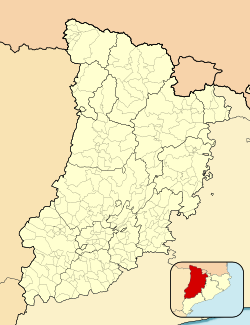Tremp
Tremp | |
|---|---|
 | |
| Coordinates: 42°10′N 0°54′E / 42.167°N 0.900°E | |
| Country | |
| Community | |
| Province | Lleida |
| Comarca | Pallars Jussà |
| Government | |
| • Mayor | Sílvia Romero i Galera (2023-)[1] |
| Area | |
• Total | 302.8 km2 (116.9 sq mi) |
| Elevation | 468 m (1,535 ft) |
| Population (2018)[3] | |
• Total | 5,824 |
| • Density | 19/km2 (50/sq mi) |
| Demonym(s) | Trempolí, trempolina |
| Climate | Cfb |
| Website | www |

Tremp (Catalan: [ˈtɾemp]) is a municipality in Catalonia, Spain, the capital of the comarca of the Pallars Jussà. It is the largest municipality in Catalonia in terms of area (303.97 km2 (117.36 sq mi)),[4] accounting for nearly a quarter of the total area of the comarca.
The municipality is a geographical oddity and consists of five separate territorial entities within the comarca (district) of Pallars Jussa (see image). The town of Tremp (population 5.961 as of 2023) is the second smallest of these and is situated in the valley of the Noguera Pallaresa river below Talarn and the Talarn Dam. The largest portion of the municipal territory lies to the west of the valley of the Noguera Pallaresa and stretches as far as the Noguera Ribagorçana river. A third portion is an exclave of the comarca within the municipality of el Pont de Suert in the Alta Ribagorça. In the east the villages of Palau de Noguera, Suterranya and Vilamitjana form the fourth entity, while the fifth and smallest portion (of only 1,59 km2) is formed by the village of Puigcercós, south of Tremp.
The town is served by the C-13 road which runs along the valley of the Noguera Pallaresa.
Demography
[edit]| 1900 | 1930 | 1950 | 1970 | 1986 | 2007 | 2012 | 2018 | 2022 | 2023 |
|---|---|---|---|---|---|---|---|---|---|
| 4896 | 6454 | 6396 | 5785 | 5727 | 6022 | 6515 | 5824 | 5847 | 5991 |
Subdivisions
[edit]The municipality of Tremp includes twenty-eight outlying settlements: populations are given as of 2005 and 2023:
| Settlements | 2005 | 2023 |
|---|---|---|
| Acadèmia General Bàsica de Subofficials | 26 | 208 |
| Aulàs | 15 | 47 |
| El Castellet | 3 | 3 |
| Casterner de les Olles | 1 | 1 |
| Castissent, on the left bank of the Noguera Ribagorçana river | 20 | 15 |
| Claramunt | 1 | 1 |
| Claret | 2 | 7 |
| Eroles | 11 | 13 |
| Escarlà | 2 | 3 |
| Espills | 5 | 8 |
| Espluga Freda | 1 | |
| Espluga de Serra | 45 | 36 |
| Fígols de Tremp | 2 | 8 |
| Gurp | 8 | 18 |
| Els Masos de Tamúrcia | 12 | |
| Palau de Noguera | 85 | 53 |
| El Pont d'Orrit | 15 | |
| Puigcercós | 52 | 35 |
| Puigverd | 1 | 1 |
| Sant Adrià | 4 | 3 |
| Santa Engràcia, with sulfurous springs | 24 | 16 |
| Sapeira | 2 | 11 |
| Suterranya | 69 | 58 |
| Tendrui | 5 | 6 |
| Tercui, on a hill above the Noguera Ribagorçana | 2 | 1 |
| Torogó | 2 | 5 |
| La Torre de Tamúrcia | 17 | |
| Vilamitjana, on the road to Artesa de Segre | 207 | 152 |
Places of interest
[edit]-Les Serretes. It is a place in Vilamitjana municipality known by the finding of an important paleontological site. In this site there have found dinosaur remains that belongs to the Second biggest hadrosaur found in Spain, and the biggest of Catalonia. Also there have been found two carnívor dinosaur tooth that belongs to two new dinosaur species morphotypes.[5][6]
Picture of the dentary from les Serretes. Nowadays exposed on the Museum of Isona.
See also
[edit]References
[edit]- ^ "Pallars Digital". Generalitat of Catalonia. Retrieved 2024-01-29.
- ^ "El municipi en xifres: Tremp". Statistical Institute of Catalonia. Retrieved 2015-11-23.
- ^ Municipal Register of Spain 2018. National Statistics Institute.
- ^ The municipality of Tortosa is historically larger than Tremp, but was subdivided into five separate municipalities between 1977 and 1983.
- ^ 2014, Fuentes-Buxó, R. & Dalla Vecchia, F.M. 2014. Les Serretes, a new Late Maastrichtian dinosaur site in the eastern Tremp Syncline (Southern Pyrenees, Spain). In: Paleontologia i Evolució. Reconstructing the Terrestrial end-cretaceous paleoenvironments in Europe. pp 70.[1]
- ^ Fuentes Buxó, R. 2012. Anàlisi de restes paleontològiques del Maastrichtià superior (Cretaci superior) procedents d’un nou jaciment situat en Les Serretes (Vilamitjana, Conca de Tremp, Espanya). Treball de fi de Master de Paleontologia (UAB-UB-ICP). 129 pp.[2]
- Panareda Clopés, Josep Maria; Jaume Rios Calvet; Jose Maria Rabella Vives (1989). Guia de Catalunya (in Catalan). Barcelona: Caixa de Catalunya. ISBN 84-87135-02-1.
External links
[edit]- Official website (in Catalan)
- Government data pages (in Catalan)Catalunya] (in Catalan)






